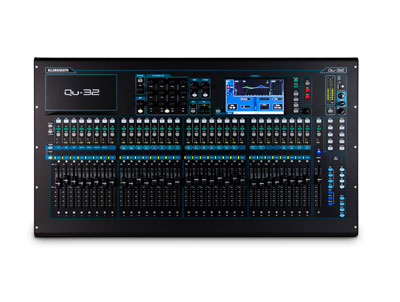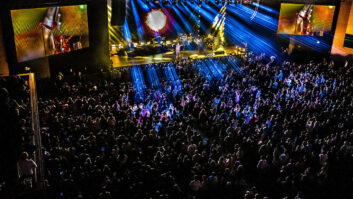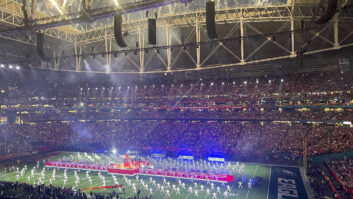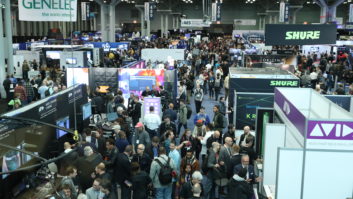
Space and weight are always an issue in live sound, and manufacturers have answered the call in the latest range of mixers and controllers. This month’s roundup features mid- to large-frame digital desks released since AES 2012, and includes a sidebar featuring the latest rackmount I/O and DSP boxes controllable from an iPad, laptop or touchscreen.
Allen & Heath Qu-32
The Qu-32 is the flagship digital mixer in Allen & Heath’s Qu Series, with 32 mic/line inputs (TRS plus XLR), three stereo inputs (TRS), 24 mix outputs (XLR), two Stereo Matrix outputs, four Stereo Groups, four DCA Groups, four FX Engines, four FX Sends/Returns, 33 motorized faders, a 7-inch touchscreen, one motorized fader per channel, Allen & Heath’s AnalogiQ recallable preamps, and the onboard Qu-Drive 18-channel USB recorder. Qu-32 is a self-contained mixer with all the I/O on the back, and plus, the dSNAKE port adds the option to connect to a family of remote AudioRacks over a Cat-5 digital snake, so the I/O can be positioned onstage.
Avid S3L-X
The Avid S3L-X is a scalable, Ethernet AVB-networked modular live sound mixing system. It allows you to streamline FOH, monitor, and broadcast workflows by sharing the same I/O across multiple S3L-X systems, with full automatic gain compensation. Once you’re out of the venue, you can set up a mobile recording/mixing studio using just the VENUE S3 surface and Pro Tools Software on a computer. The X gives you double the ram of the S3L, a higher output, lower noise headphone amp and is ready to record directly to Pro Tools or other DAWs.

Behringer X32
Behringer’s X32 is a 40-input channel, 25-bus console for studio and live sound applications. It features 32 fully programmable mic preamps, designed by MIDAS, as well as 16 configurable mix buses and digital I/O. Its 25 fully automated motorized 100mm faders allow for instant overview, scene management and DAW control. X32 has 16 XLR outputs plus six additional line in/outputs, two phones connectors and a talkback section with integrated or external mic. It provides individual and dynamic LCD Scribble Strips on all channels and buses. Dual AES50 ports allow for direct connection of optional S16 remote stage boxes for a total of 96 remote inputs, or direct to other X32s for mains/monitor/broadcast applications. A 32×32-channel USB 2 audio interface with DAW remote control allows for interfacing with any compatible DAW, while the console’s Ethernet port allows external control either from a PC or an iPad using the company’s free software.

DiGiCo SD9
The SD9 is a lightweight, small-footprint console with a completely integrated system powered by Stealth Digital Processing and floating point Super FPGA technology, designed for touring or fixed installations. The SD9’s I/O section includes eight mic inputs, eight line outputs, four mono AES/EBU, one MADI port, and two dedicated D-Rack Ports. The SD9 features 24 touch-sensitive motorized faders and quick access function buttons. The console’s work surface has a 15-inch, high-resolution TFT LCD touch screen with backlit display, along with dedicated multi-function control knobs and electronic labeling. The SD9 features 48 Flexi Channels (configurable as either mono or stereo) at 48/96 kHz, the equivalent of 96 channels of full DSP processing. Standard channel processing, whether inputs or outputs, includes Channel Delay, Single and Multi-Channel Presets, dual insert points, highpass and lowpass filters at 24dB/octave, 4-band parametric EQ with band curve selection, Dual insert points, DiGiCo’s DYN 1 (Compressor, De-Esser or assignable Multi-Channel Compressor) and DYN 2 (Gate, Compressor or Ducker).

Fairlight EVO.Live
The EVO.Live is targeted specifically at broadcast and fixed installations. Comprising a modular console, a separate processor rack with Local I/O, and Remote I/O, the console comes in a variety of chassis styles and sizes (up to 60 faders), and can be easily customized to create an optimized mixing environment for live production applications. All traditional broadcast functions are catered for, including up to 16 mix-minus buses; advanced comms and talkback facilities; up to 24 sub and 24 aux buses (up to 5.1); and advanced metering. In terms of raw processing, the system delivers up to 104 input channels and 112 mix elements, all fully featured with EQ, filters and dynamics. Based on Fairlight’s leading edge audio processing and control surface hardware, EVO.Live can switch between live and post-production modes at the touch of a button. Post mode brings into play a fully integrated audio and video editor, plug-in support and a variety of interchange file formats.

Midas PRO X
Designed and engineered in England, the PRO X Control Centre features the company’s Neutron Audio System Engine, 29 MIDAS PRO motorized 100mm faders, two 15-inch full color TFT display screens that are said to be viewable in daylight, 168 simultaneous input channels and 99 time-aligned and phase-coherent buses with no trade-offs in channel or bus counts. Ten VCA and eight POPulation groups, combined with the advanced navigation offered by the new output-centric center section, allows the simultaneous display of 24 mono or stereo mix buses. Neutron is the result of a three-year research and development program. Its latest generation DSPs and high-performance FPGA, coupled with tightly-coupled MIMD (Multiple Instruction, Multiple Data) architecture, delivers more than 100 gigaflops of real-time audio processing performance. MIDAS states that the Neutron has the potential to provide more than 800 audio paths. AES50 connectivity allows for up to 288 network inputs and 294 network outputs for the PRO X system.

Peavey FX2 24
The FX2 Series feature 3-band EQ with sweepable mid-frequency and variable low cut filters, two stereo channels with dual mic/line inputs, six Aux sends, four subgroups, and 24 100mm faders. FX2 mixers also offer Peavey’s exclusive Silencer mic preamps, which allow very high gain with low noise and distortion for crystal-clear signal reproduction. The four pre-fader auxes per channel provide four monitor mixes, while the two post-fader auxes are ideal for adding built-in or outboard effects. These mixers also include dual DSP engines that allow multiple simultaneous effects assignable to any channel via aux 5/6. Onboard effects include reverb, reverb enhanced, delay, compression, expander, de-esser, chorus, flanger, tube emulator, vocal enhancer and gate. Chain two processors together on each of the two available effects windows. The digital output processing section includes Feedback Ferret, dual 5-band Parametric EQ or dual 28-band Graphic EQs, digital delay lines, and dynamics/limiters.

PreSonus 32.4.2AI Live Mixer
The StudioLive 32.4.2AI 32-channel digital mixer features the company’s Active Integration technology, including a dual-core computing engine, and allows for wireless control without an external computer. It offers 32 Class-A XMAX mic preamps with individually switched phantom power (plus an XMAX preamp for the Talkback input with always-on phantom), 32 line inputs, 14 aux mixes, four subgroups with variable output delay, Fat Channel dynamics processing and parametric EQ, and a 48×34 FireWire S800 audio interface. The 32.4.2AI allows users to create two complete sets of EQ and dynamics settings for a channel and then make quick A/B comparisons with the Alt EQ/Dyn button. This model also has six mute groups with All On/All Off switches and six user-assignable Quick Scene Recall buttons that let you load specified, saved mixer scenes. The StudioLive 32.4.2AI also has four internal effects buses: two with reverb and two with delay effects, an Ethernet port and a USB 2 port.

Roland M5000
The M-500 is Roland’s first product based on O.H.R.C.A, which stands for “Open”, “High Resolution”, and “Configurable Architecture”. The M-5000 offers freely definable audio paths, supporting multiple audio formats protocols, plus 96kHz sound quality throughout the system. The Roland M-5000’s internal mix architecture is not fixed and can be freely defined for mixing channels, AUXs, Matrices, subgroup buses, Mix-Minus buses within a range of up to 128 audio paths allowing user to create a console structure to suit the needs of the application. The M-5000 has two built-in REAC ports, plus two expansion card slots for Dante, MADI, Waves SoundGrid, or more REAC ports, as well as future formats. The back panel includes 16×16 analog I/O, 4×4 AES/EBU, a 16×16 USB audio interface, connection for control via an iPad connected or wireless, and control ports including footswitches, GP I/O, RS-232C and MIDI.

Soundcraft Vi4
The Soundcraft Vi4 model inherits the functionality and facilities of the Soundcraft Vi6—including the Vistonics II touchscreen user interface, Soundcraft FaderGlow fader function display and Vi6’s audio quality—but in a smaller, more compact footprint. In just under 5 feet, the Soundcraft Vi4 offers access to 96 inputs on 24 faders, with a total of 35 output buses available for use as masters, groups, auxes or matrices. Pairs of mono inputs can be linked to create stereo channels. Its 24 insert send/return pairs can be configured (using available I/O) and assigned to any of the 96 inputs or 35 output channels. All 96 input channels can have direct outputs in addition to their internal bus routing, assuming sufficient I/O is available (for example, an optical MADI card). Buses comprise 32 Group/Aux/Matrix, plus main L/C/R Mix and L/R Solo buses (maximum of 16 matrix outputs can be configured).

SSL Live L500
Solid State Logic’s Live L500 console, which is priced depending upon the configuration, launched in 2013 as the company’s first console for live sound production. Live brings SSL’s approach to audio quality and console ergonomics to sound for the stage. SSL Live is suited to touring or installation, front-of-house or monitors in venues and arenas, houses of worship and concert halls. Based on SSL’s Tempest processing platform, Live offers 976 inputs and outputs, and 192 full processing audio “paths” at 96 kHz. “Paths” are flexibly configured with power allocated to Channels, Auxes, Stem Groups and Masters configured to suit the needs of each show. All processing is built into the console surface. It has a collection of I/O connectivity built into the frame. A full range of Stagebox I/O connects to the console via MADI.

Yamaha Pro Audio CL Series
The Yamaha CL Series comprises the CL1, CL3 and CL5, differing only in channel capacity, fader complement and metering. All models feature the same 8-fader Centralogic user interface, two-fader master section (one L/R and one Mono), eight analog Omni inputs and eight analog Omni outputs on rear-panel XLRs. Rear panel connections include MIDI and word clock I/O, AES/EBU output, Ethernet ports for the onboard Dante network interface and three mini-YGDAI expansion slots. The console has an IEC connector for its onboard power supply, plus a port for connection to a redundant outboard supply. A meter bridge for the CL1 is optional and may be added at any time. The QL Series includes features and performance inherited directly from the CL Series such as built-in Dante networking that facilitates flexible system configuration and expandability. The compact QL Series consoles offer all-in-one mixing, processing, and routing capability for small to medium scale live sound, corporate speech events, installations, and much more.

VIRTUAL CONSOLES
Although simple looking, rackmount boxes with DSP and I/O for live sound offer a wide range of features including Wi-Fi for remote control, integration with popular tablets and pads, expansion slots for adding features and more.
Behringer XR18 X-Air
The XR18 is an 18-input/12-bus portable mixer housed in a sturdy stage box design for use with iPad and Android tablets. It includes 16 MIDAS-designed mic preamps, integrated Wi-Fi module for wireless control, and an 18×18-channel bi-directional USB audio interface. Based on the Dan Dugan automix system, the XR18’s gain sharing technology can manage fully automated mixes with up to 16 live microphones. XR18 includes the X32 effects rack featuring four stereo FX slots. It includes a 100-band Real Time Analyzer (RTA) for all channel and bus EQs; Ultranet connectivity for Behringer’s P-16 Personal Monitoring System; rack ears and protection bumpers; six aux and main L/R buses with inserts, full dynamics processing and 6-band parametric or 31-band graphic EQ; six XLR aux outputs and two XLR main outputs plus phones connector.

Computer Integrated Audio Digital Console
CIA Digital Virtual Consoles are housed in a 6U rolling rack weighing less than 90 pounds that have up to 24 motorized faders powered by RML Labs’ Software Audio Console. A total of 25 separate consoles in one virtual environment use a legacy console strip GUI metaphor. Each of the 24 monitor mix consoles can be remotely controlled via a remote computer through a TCP/IP connection. The digital split is internal and provides an exact zero noise copy of the up to 72 inputs to all 25 consoles. All 25 consoles have 72 inputs and 24 stereo outputs with built-in attenuator, phase reverse, swap L/R, mono, mastering 5-band paragraphic EQs with Hi and Lo cut filters, keying gates and compressors with a bandpass filter, six stereo aux sends with pan, pre and post FX patches, full 8-point surround X/Y panners, plus a separate center and sub send, 24 stereo out assigns, mute, solo and long throw faders with -60dB high resolution meters on each input channel.

Line 6 StageScape M20d
The StageScape M20d features a touchscreen visual mixing environment, DSP power for audio processing on every channel including multiband feedback suppression, multichannel recording and remote control capabilities. In Perform Mode, a graphic display of the stage setup uses icons to represent each performer or input. Color-coded encoders provide immediate access to level control. A single touch on a performer’s icon gives access to all parameters relating to that channel. The audio signal chain can be controlled via an X-Y tweak pad. Deep Edit mode provides access to every effect parameter via a plug-in style interface. Auto-sensing mic and line inputs and outputs can detect when a connection is made and automatically configure the channel gain, EQ, effects and routing. Fader View is available on the StageScape M20d display as well as the StageScape Remote iPad app. Equipped with the L6 LINK digital networking protocol, StageScape M20d allows musicians to configure and control P.A. systems of any scale.

Mackie DL32R
The 3U rackmount Mackie DL32R is a 32-channel digital mixer with Onyx mic pre’s that is controlled wirelessly from an iPad running Mackie’s Master Fader control app. It gives you 36 input channels with 4-band parametric EQ plus HPF, gate and compression; 32 stereo-linkable input channels; four stereo-linkable return channels; and 28 output buses with 4-band parametric EQ plus HPF/LPF, 31-band GEQ, compressor/limiter and alignment delay. The DL32R includes 14 fully assignable XLR outputs and stereo AES digital output. It also features direct-to-disk multitrack (24×24) recording and playback, and functions as a USB 2 audio interface for a Mac or PC. The DL32R supports up to 10 separate iOS devices at once.

Presonus StudioLive RM
Based on the StudioLive AI-series engine and controlled with UC Surface software for Mac, Windows and iOS (supporting iPad and Windows 8 touchscreens), the StudioLive RM16AI and RM32AI 32x16x3 rack-mount Active Integration digital mixers are scalable, compact, and 100 percent recallable. The 3U rack-mount RM16AI provides 16 locking XLR inputs with recallable XMAX Class-A preamps, eight XLR line outs, and three main outs (left, right, and mono/center); 32 internal channels and 25 buses; a 52×34 FireWire 800 recording interface; 96 kHz operation; and extensive signal processing. The 4U rack-mount RM32AI offers 32 inputs with recallable XMAX preamps and 16 line outputs but otherwise has the same features as the 16-input version. Both mixers offer individual 48-volt phantom power on all inputs; a +48V Meters button displays phantom-power assignment on the input meter grid.






